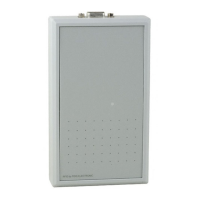OBID i-scan
®
System-Manual ID ISC.MR/PR/PRH101
FEIG ELECTRONIC GmbH Page 14 of 131 H60301-3e-ID-B.doc
rotocol block
rotocol c
cle
t
+ t
1.3. Scan-Mode
In this operation-mode the Reader autonomously sends out data to the host as soon as a Trans-
ponder is within the detection range and valid data could be read.
In Scan Mode the contents of the message block (UID, data block) can be adapted to each user-
application. Scan mode is available via the asynchronous Interface and the USB Interface.
If an USB-Reader is used in scan mode, the reader sends its data automatically over the HID interface
of the operating system. In this case, you cannot catch the data with the FEUSB.DLL or any other li-
braries. The reader works like a keyboard. (see also: 3.7. CFG6: Scan-Mode1).
The Reader starts the output of the protocol block as soon as all required data have been read cor-
rectly from the Transponder. If the number of transmitted user data is too large, only the maximal
number of transmitted data will be sent plus the end character.
Scan-Mode via asynchronous interface:
The data will be sent out depending on their configuration according to the following scheme,
the sequence of which cannot be changed.
Depending to the configuration and the number of Transponders in the detection range of the
Reader the transmitted protocols have a different format.
Example 1:
One Transponder in detection range and UID and data block should be read:
PR SC UID SC data EC PR SC UID
Example 2:
3 Transponder in detection range only UID should be read:
PR SC UID1 EC UID2 EC UID3 EC
Example 3:
3 Transponder in detection range only data block should be read:
PR SC data1 EC data2 EC data3 EC
Example 4:
2 Transponder in detection range UID and data block should be read:
PR SC UID1 SC data1 EC UID2 SC data2 EC
PR: Com-Prefix (optional) ts: SCAN-LOCK-TIME
UID: Serial-Number. (fix) tr: time to the next new Transponder reading
data: data blocks (free programmable)
SC Separation character (optional)
EC End character (optional)

